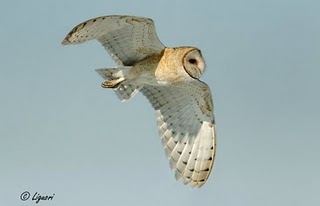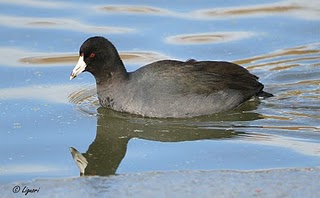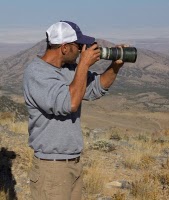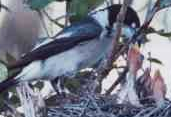Photography and Bird Identification
by Jerry Liguori (Author and Bird Photographer)
 Equipment Advances:
Equipment Advances:
Camera equipment has advanced in many ways in recent years, the biggest advancement has been in digital photography. Yes, film cameras can take beautiful photos, especially medium and large format landscapes and the like, but for overall image quality and usefulness regarding bird photography, particularly in-flight, digital equipment is far superior (see images on left). One of the most valuable features of digital photography is the ability to review images on-the-spot through the rear viewfinder. I remember having to wait at least 2 weeks to get a roll of slides back, only to be disappointed with the results. Nowadays, you can review your images instantly to get a feel for the exposure, contrast, sharpness, or composition. The ability to adjust tone, contrast, saturation, and sharpness on-the-spot as conditions change is another valuable option offered by the newer digital cameras. However, overdoing certain adjustments may result in a negative effect. High quality digital cameras also perform better in low light and at high ISO settings than film. Manufacturers try to make improvements each year regarding the precision of the auto-focus and other functions, and this is evident when comparing older model film or digital cameras to new models. Another advantage of digital images is that they are much easier to store and archive than are prints or slides. Some digital cameras offer video recording, and I'm sure most or all will in the future.
Just a note about shooting JPEG vs. RAW. The image size and resolution of JPEG (high quality setting) and RAW photos are the same (but the file size of a JPEG image is smaller). There are advantages to both settings, but the overall advantage of shooting JPEG is greater. This issue can be argued to death, as opinions differ, and alone is worthy of an entire article, which I don't have the energy or time for...but I have tested both settings and compared the results. On most cameras, there is an option to shoot both JPEG and RAW simultaneously, but there are drawbacks in doing so. I just don't prescribe to the theory of shooting RAW "just in case" because a strong enough case has not been made.
Field Observation:
I was a birder long before I took up photography. I studied birds intently and made mental and physical notes as often as I could. My only tools were my binoculars and a notepad....both of which I still carry today (and recommend every birder should). Before 1995, I conducted field jobs and hawk counts without ever taking a photograph, so, I can see how my own attitude and manner in which I study birds has changed from before owning a camera to after. The downside of taking pictures is that I pay much less attention to details of birds and more attention to capturing an image. Is this really a downfall? I don't believe so because I can point out specific details through photographs that would be impossible otherwise. I have used photography as a tool to improve my birding skills by seeing which specific traits in photographs can or can't be relied on in the field. I do find myself neglecting to look at birds altogether at times, and focused on photographing them only. I still enjoy watching birds (well, hawks that is), but I have different goals now than I used to, and these goals include photography in one way or another. It is possible that some new birders start off with a camera and may never truly learn how to observe bird behavior or distinguish vocalizations.
notes as often as I could. My only tools were my binoculars and a notepad....both of which I still carry today (and recommend every birder should). Before 1995, I conducted field jobs and hawk counts without ever taking a photograph, so, I can see how my own attitude and manner in which I study birds has changed from before owning a camera to after. The downside of taking pictures is that I pay much less attention to details of birds and more attention to capturing an image. Is this really a downfall? I don't believe so because I can point out specific details through photographs that would be impossible otherwise. I have used photography as a tool to improve my birding skills by seeing which specific traits in photographs can or can't be relied on in the field. I do find myself neglecting to look at birds altogether at times, and focused on photographing them only. I still enjoy watching birds (well, hawks that is), but I have different goals now than I used to, and these goals include photography in one way or another. It is possible that some new birders start off with a camera and may never truly learn how to observe bird behavior or distinguish vocalizations.
When it comes to a rare bird reported, the first thing people ask now is, and I find myself doing it, "where's the photo?" I think everyone expects to see photos accompanied with rare sightings since so many people walk around with cameras nowadays. It isn't possible to photograph every bird, and many people do not carry a camera around, so field notes are the only documentation available. Often, the better the observer, the better the field notes...but some descriptions just don't make sense. Even a poor photo can be valuable and clinch or negate an ID. On the other hand, a single photo is sometimes impossible to identify, and a description is the clincher to the ID. Regardless, there is no argument that a decent or good photo is much more reliable and identifiable than written notes. I have read perfectly detailed, in depth write-ups up qualified by "I am positive it was a such-and-such" only to see the photo (or photos) that proves the identification to be a mistake. I have also seen poorly written descriptions accompanied by an acceptable photo. These days, I can't write up a rare bird with any detail because I never study it long enough to take mental notes, instead I grab for my camera and say "see photos" in the write-up. This is a lame attitude but I own up to it. Either way, rarities are fun and have value but they are the least important aspect of birding when it comes to bird conservation.
The Internet:
 Digitial photography and the internet go hand in hand. The internet is the greatest resource for sharing bird images, information, opinions, or shopping on-line for bird related materials. Years ago, the only way to see someone else's images was to have them in hand. Now, anyone can surf the net and view a multitude of images of any species. With this instant access to a myriad of images, one can compare plumages or traits of interest and learn specific aspects of birds at an accelerated rate. There are many sites devoted to birds and bird identification that are excellent learning tools. On-line sites such as Birds of North America (BNA) cover the identification, life history, vocalizations, subspecies specifics, nesting behavior, etc. for all species occurring in North America. eBird is another site that is unlike any other in that birders can enter their bird sightings into a managed, structured, formatted database. This database makes it easy for people to keep track of all their personal sightings, or view all sightings reported of certain species or area. Seasonal maps of distribution or trends of birds is available as well, along with a host of other functions.
Digitial photography and the internet go hand in hand. The internet is the greatest resource for sharing bird images, information, opinions, or shopping on-line for bird related materials. Years ago, the only way to see someone else's images was to have them in hand. Now, anyone can surf the net and view a multitude of images of any species. With this instant access to a myriad of images, one can compare plumages or traits of interest and learn specific aspects of birds at an accelerated rate. There are many sites devoted to birds and bird identification that are excellent learning tools. On-line sites such as Birds of North America (BNA) cover the identification, life history, vocalizations, subspecies specifics, nesting behavior, etc. for all species occurring in North America. eBird is another site that is unlike any other in that birders can enter their bird sightings into a managed, structured, formatted database. This database makes it easy for people to keep track of all their personal sightings, or view all sightings reported of certain species or area. Seasonal maps of distribution or trends of birds is available as well, along with a host of other functions.
***
Jerry Liguori (pictured above) is an author and wild life photographer who lives in Utah. This article is reprinted with kind permission of the author. The article first appeared on A Blog for Utah Birders.
Books by Liguori include Hawks At A Distance: Identification of Migrant Raptors and Hawks From Every Angle. For my review of Hawks At A Distance click here. For more details of the books see:

 del.icio.us
del.icio.us Digg
Digg Facebook
Facebook Google
Google Google+
Google+ LinkedIn
LinkedIn MySpace
MySpace Ping This!
Ping This! SlashDot
SlashDot StumbleUpon
StumbleUpon Twitter
Twitter Yahoo
Yahoo




Comments
Giving them care would mean
Giving them care would mean saving the nature. This small creatures add color to the world and it seems nature would not be that complete without their voices spreading through the air. Just bothered about other species are starting to be endagered. Just remember that we can never demand nature unless we obey her. Giving it extraordinary care would mean giving them chance to live for the next generation. Its just like lending it private loans.